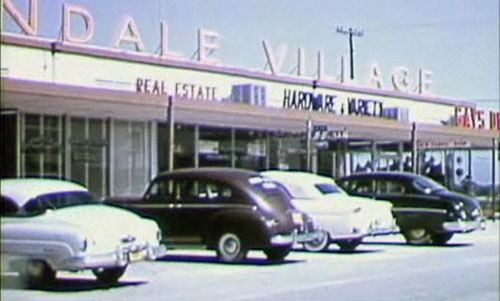TAMI Flashback: 'Automobile Thefts' and 'No Chance'

This article is the third in a Slackerwood series about the Texas Archive of the Moving Image (TAMI) video library.
The classic noir thriller The Naked City ends with a memorable line: "There are eight million stories in the Naked City; this has been one of them."
There aren't quite as many stories in the River City, but Austin has plenty of crime nonetheless. And crime in Austin is the subject of two priceless TAMI videos featured in this article, Automobile Thefts -- A Police Training Aid and the provocatively titled No Chance.
Made in Austin c. 1953, Automobile Thefts is exactly the sort of mundane but now fascinating film that makes TAMI so special. Produced by the National Automobile Theft Bureau and the Texas Department of Public Safety, it's a training aid to help law enforcement more effectively combat car thieves. Thrilling it's not; its dry explanations of theft techniques and investigative procedures aren't exactly gripping entertainment. But like so many TAMI videos, Automobile Thefts captures mid-century life like no narrative film ever could.
In classic 1950s style, Automobile Thefts opens grandly. To the soundtrack of a stately march, we witness a staged car theft. But fear not -- The Law is doing all it can to fight this menace, telling us so in wordy, blocky text that crawls up the screen: "It is the sincere desire of these agencies that the material presented herein will be of great value to police generally as a training aid in the study and development of more effective means and methods in combating automobile thefts." (With the crawling text and marchy musical accompaniment, I expected to read that rebel spaceships, striking from a hidden base, have won their first victory against the evil Galactic Empire.)
Legendary Texas lawman Col. Homer Garrison, Jr. then explains the scope of the problem -- some 215,000 cars were stolen in the U.S. every year. (FYI, that number is now about 800,000.) Garrison also reassures us that with proper law enforcement training and common-sense precautions, we can fight back effectively. This has not changed.
All of this would be of little interest, of course, if not for the film's generous footage of vintage Austin. Due to the close-in camerawork -- and because Austin has changed so drastically in 58 years -- recognizable landmarks are relatively few. But there are many scenes of semi-rural roads and freshly built, treeless postwar suburbia, most likely shot in then-new Allandale. The most striking visuals are in scenes where cars are stolen from what appears to be an isolated strip mall surrounded by open land. Look closely at the sign atop the stores, and you'll see that the lonely strip mall is actually Allandale Village. Of course, the open land is now a distant memory.
Complementing the shots of Lost Austin are shots of lost crime fighting technology -- endless stacks of card files, large and clunky typewriters and larger, clunkier teletype machines. The technology is in the capable hands of well dressed, immaculately coiffed women who assist squared-jawed Texas lawmen (wearing Texas lawman hats, of course) in their investigations. We can be grateful that although car theft remains a major problem, at least the cops have computers now, and hairstyles are more casual.
[View original at Texas Archive of the Moving Image.]
In contrast to Automobile Thefts, No Chance begins ominously and is hardly mundane. It opens on a dark screen as a narrator tells us, "Dope pushers, their suppliers, auto theft rings, fences of stolen property, dealers in pornography, prostitution, and murder. This is organized crime in Texas, and if you think something like organized gambling can't hurt you...watch."
And by all means, watch! What follows is a fascinating, Austin-made early Seventies crime drama that, if not for its microscopic budget and a few production gaffes, could be an episode of The Streets of San Francisco or Kojak. I half expected Karl Malden to hop out of a police car on Congress Avenue.
Produced in 1973 by the Texas Criminal Justice Council and the Texas Department of Public Safety, No Chance is based on DPS case files and follows a group of Texas lawmen as they pursue a notorious and violent illegal gambling racket. The film is a plea to support legislation allowing wiretapping in Texas, which law enforcement needed to help bust organized crime rings.
The story is straight out of Adam-12. A young couple owes the gambling ring money, and when a pair of thugs confronts the couple at a drive-in, things don't end well. The cops easily catch one of the thugs, who fingers his accomplice but won't rat on the ringleaders. A bit of detective work leads the cops to the accomplice, who then leads them on a classic cop show chase through the deserted streets and alleys of Austin's warehouse district. Do the crime bosses get their due? No Chance is an unusual TAMI video with an actual plot, so to avoid spoilers I won't say any more about the story.
If I reviewed No Chance like a feature film, I'd say it's rather great stuff, or at least an entertaining home-grown approximation of rather great stuff. It includes plenty of action, deliciously evil bad guys clad in fashionable polyester, sympathetic victims, and hardened cops who've seen it all. Yeah, the acting and editing are uneven and some plot points don't make sense, but so what? Just enjoy the jazzy and delightfully clichéd Seventies soundtrack (complete with a Hammond organ) and watch the parade of old Austin landmarks, including a very different Congress Avenue, Calcasieu Lumber, empty warehouses that are now thriving bars and restaurants, and a long-gone drive-in I couldn't identify.
Fans of Austin film history may find No Chance especially interesting, as they may recognize the actor who plays the ill-tempered criminal Lester Nolan. He's Bill Vail; a year later, he starred as Kirk in a slightly more memorable crime movie, The Texas Chain Saw Massacre.

